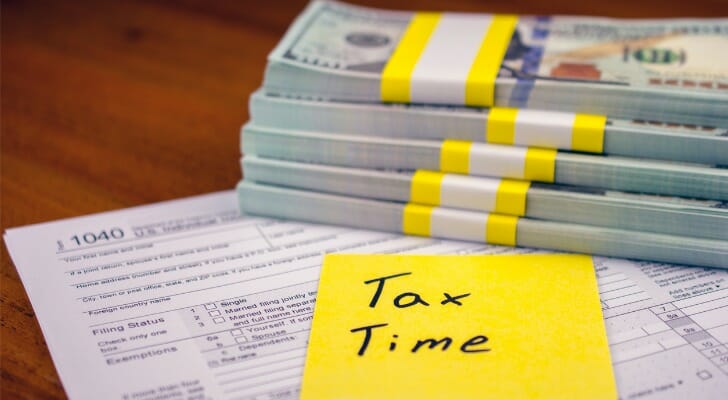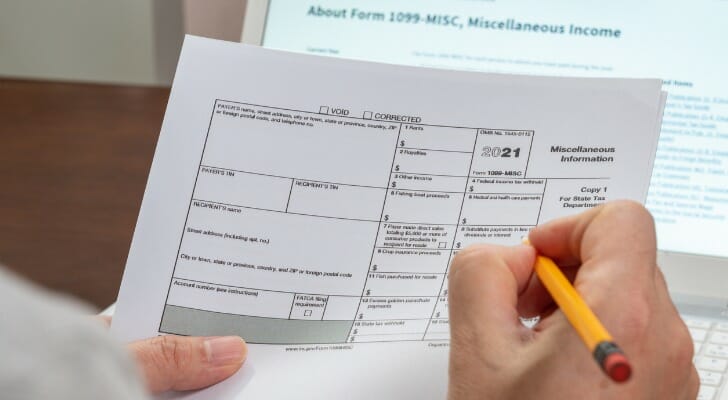 Dividends can be an important part of your income from investments, especially if you have significant fixed-income holdings. Internal Revenue Service Form 1099-DIV supplies you with all the information on your dividend income that you will use when you file your income taxes. Here are some instructions to assist you in preparing the dividend income portion of your federal tax return. Dividend reporting, though, can be tricky so consider working with a financial advisor as you create and maintain a tax-efficient portfolio.
Dividends can be an important part of your income from investments, especially if you have significant fixed-income holdings. Internal Revenue Service Form 1099-DIV supplies you with all the information on your dividend income that you will use when you file your income taxes. Here are some instructions to assist you in preparing the dividend income portion of your federal tax return. Dividend reporting, though, can be tricky so consider working with a financial advisor as you create and maintain a tax-efficient portfolio.
What Are IRS Forms 1099 and 1099-DIV?
Form 1099 is an informational form that shows how much money you have received during a calendar year from a financial institution. It serves many purposes. It is not only used to report dividends but also retirement distributions, lottery winnings, interest payments, lawsuits, divorce settlements and real estate transactions, as well as dividend payments.
The official name for Form 1099-DIV, on which dividends are reported to taxpayers each tax year, is Internal Revenue Service (IRS) Form 1099-DIV: Dividends and Distributions. This form is used by banks, credit unions, mutual funds and other financial institutions to report the dividends paid to a taxpayer each calendar year.
For 2022, if you received more than $10 in dividends from one of these institutions, you will receive a Form 1099-DIV. If you received dividends from more than one entity, you will receive a Form 1099-DIV from each of them. The businesses also submit a copy of each Form 1099-DIV you receive to the IRS.
You do not file this form with your taxes. Instead, you take the information from the form and use it in several locations on your tax return.
What Are Dividends and Distributions?
Publicly traded companies can decide what to do with profits. They can reinvest them to grow the company and raise share prices or they can pay some of their profits to shareholders as dividends.
Dividend payments to shareholders are a portion of a firm’s net income, or profit, that they do not need for growth. Instead, the firm distributes the extra profit to its shareholders. Often, businesses compensate their shareholders for a lower growth rate in share price by paying out dividends. The remainder of a firm’s net income is retained by the firm for the growth of the business.
A distribution is similar to a dividend with one major difference. Like the dividend, corporate profits can be paid out to shareholders but a distribution occurs when this happens from an S-corporation while a dividend occurs with C-corporations. You use the same IRS form to file these taxes as the shareholder.
When to Use Form 1099-DIV, and When Not to
 Unless you received $10 or more in dividends from some type of financial institution, you will not receive a Form 1099-DIV. Companies do not have to report dividends received to you on a Form 1099-DIV unless they have paid you $600 or more.
Unless you received $10 or more in dividends from some type of financial institution, you will not receive a Form 1099-DIV. Companies do not have to report dividends received to you on a Form 1099-DIV unless they have paid you $600 or more.
Even if you don’t receive this form from one of the entities that paid you dividends, you must report all dividend income you have received on your tax return. Sometimes your Form 1099-DIV is included in your year-end statement if you have a brokerage account. In this case, you may not receive a Form 1099-DIV separate from your brokerage statement. You are still responsible for reporting the income on your taxes.
You use Schedule B to list the dividends you have received during the tax year if they are ordinary dividends and more than $1,500. Ordinary dividends include those paid on stock, employee stock options and real estate investment trusts (REITs).
Information on a Form 1099-DIV
As a taxpayer, you should be able to read Form 1099-DIV and understand where you use the information from it on your tax return. Here is an explanation of the information on Form 1099-DIV.
- Box 1a – This amount represents all the dividends you have been paid from each payor. It is the ordinary dividends including those from stocks, mutual funds and exchange-traded funds. You report this amount on Line 3b of IRS Form 1040 and Schedule B if required.
- Box 1b – This amount may be all of the amounts in Box 1a or only part of it. It is the number of qualified dividends you have received from the payor. Qualified dividends are reported on Line 3a of Form 1040.
- Box 2a – Capital gains distributions from mutual funds and exchange-traded funds are reported here. Individual stocks do not make capital gains distributions. If you have held the stocks for more than one year, you will be taxed at the long-term capital gains rate. That tax rate is much lower, usually than the tax rate on short-term capital gains.
- Box 3 – Non-dividend distributions by companies are included here. In many cases, this amount is non-taxable and provided only for informational purposes.
- Box 5 – Section 199A dividends are recorded here. This amount is the dividends from domestic real estate investment trusts (REITs). It is reported on IRS Form 8995.
- Box 7 – Foreign tax paid is listed in Box 7. The amount in this box reduces your federal tax liability and should be claimed on IRS Form 1040. Depending on the amount, you may also have to complete IRS Form 1116.
- Boxes 11 and 12 – Box 11 shows the number of tax-exempt dividends you have received. They are exempt from federal taxes. Box 12 is a portion of Box 11 which could trigger the alternative minimum tax.
The Bottom Line

IRS Form 1099-DIV is a common tax form has a wealth of information included that may affect your tax liability. Using this information to complete your tax return, along with Schedule B if necessary, will help you file a correct income tax return. Remember, before you file your income taxes, make sure you have all the Form 1099-DIVs that you are supposed to have. Also, check with any company that should have sent one and didn’t after Feb. 15. Also, don’t forget to include dividends that did not trigger a Form 1099-DIV.
Tips for Tax Planning
- You don’t need to plan for and manage your taxes on your own. Instead, consider working with a financial advisor to help with your taxes and tax strategy. SmartAsset’s free tool matches you with up to three financial advisors who serve your area, and you can interview your advisor matches at no cost to decide which one is right for you. If you’re ready to find an advisor who can help you achieve your financial goals, get started now.
- Calculate your federal income tax by using SmartAsset’s income tax calculator.
Photo credit: ©iStock.com/Roman Didkivskyi, ©iStock.com/tumsasedgars, ©iStock.com/Jae Young Ju